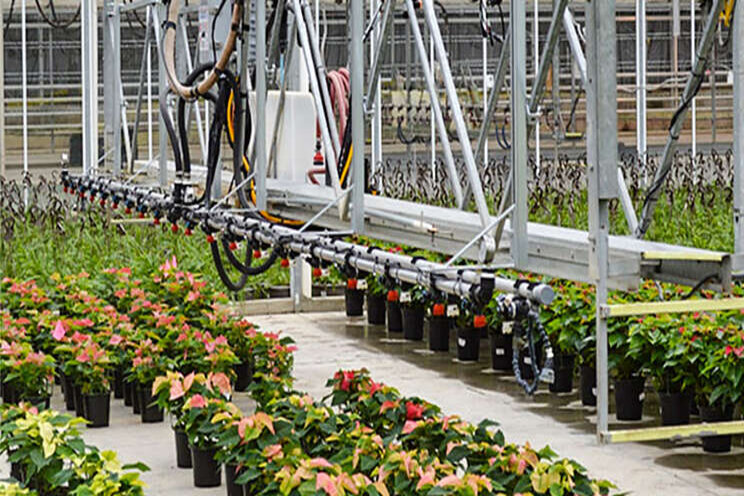Get the most out of your greenhouse sprayers
Added on 23 March 2021

Several types of sprayers are available commercially for use in greenhouses. Each has benefits and limitations, and there is no one best choice; however, certain sprayers may be more effective for pest management/plant protection programs depending on the greenhouse facility.
Methods of Low-Volume Application
Low-volume (LV) greenhouse sprayers use a small volume of pesticide. The same amount of active ingredient is applied, but the chemical is broken into smaller droplets. Low volume sprayers also include ultra-low volume sprayers, which produce even smaller droplet sizes. Several LV application methods are available, including:
- Ready-to-use aerosols: The chemical is in a pressurized canister that produces a fog when released.
- Thermal pulse-jet foggers: The pesticide is injected into a hot stream of air that vaporizes the pesticide into small droplets. A carrier is mixed with the pesticide to improve uniformity of droplet size. High temperatures and low humidity result in rapid settling of the pesticide, resulting in the pesticide collecting on the upper leaf surface.
- Cold foggers/high-pressure hydraulic: High-pressure pumps and atomizing nozzles are used to produce mist-sized droplets. A spray stream is formed that may reach 10 to 12 feet.
- Mechanical aerosol generators: These are designed to be operated from a single position unattended inside the greenhouse. Air-atomizing nozzles are used to form small droplets.
- Electrostatic applicators: Spray droplets are electrostatically charged, which results in the droplets being attracted to both sides of the leaf surface. Handheld and unattended models are available.
For more information on spray application methods and equipment, check out this guide from the University of Tennessee.
Four Sprayer Misconceptions
Misconception: Assuming your greenhouse sprayers are always providing uniform spray coverage.
"The use of yellow water-sensitive spray cards should be part of your routine," says Frank Hale, a Professor and Extension Specialist at the University of Tennessee's Soil, Plant, and Pest Center. "I have received many calls over the years where a pesticide application doesn't control the pest. Many of these control failures end up being due to poor spray coverage. The targeted plant surfaces need to have an even deposition of the tiny droplets needed to contact plant pests, especially when trying to control tiny pests such as thrips and mites."
Misconception: Your pest control program should be the same year after year.
"We have more modes of action available in greenhouse pesticides now than ever before," Hale says. "Rotation between different mode of action pesticides will slow pesticide resistance. Try to learn more about the new products to see if they can be used effectively in your pest management program."
Misconception: Assuming your sprayer tip is working properly.
"Growers rarely check to see if there is a difference in output," says Darrell Hensley, an Extension Assistant Professor at the University of Tennessee. "You may run across more than 10% variation in the output of new tips."
Misconception: High pressure is better.
"That's not always the case," Hensley says. "The tip and pump must be able to handle the higher pressures. Also, high pressure makes smaller particles, which drifts easily."
Smart Sprayer on the Way
An intelligent sprayer for use in greenhouses is getting closer to fruition.
Dr. Heping Zhu of the USDA-Agricultural Research Service facility in Wooster, OH, designed an Intelligent Spray Control System a few years ago to help bring precision agriculture to environmental horticulture. A laser on the sprayer detects the plant canopy; that information triggers spray nozzles to activate only where plant material is present. The result is that much less spray is required.
Dr. Zhu and his team estimate anywhere from 47% to 70% reduction in pesticide needs (while still maintaining efficacy), which translates to $140 to $280 in annual cost savings per acre in nursery production. Beneficial insects also benefit through the significant reduction in pesticide drift — up to 87% reduction in general airborne drift and up to 93% reduction in drift on the ground.
Dr. Zhu is currently working to adapt this technology to greenhouse operations.
"We have developed an intelligent sprayer prototype attached to a greenhouse watering boom," Zhu says. "We have tested its automatic functions at Casa Verde Growers in Strongsville, OH. More biological tests are needed before we can introduce it to growers." Stay tuned!
Photo: Dr. Heping Zhu of the USDA-Agricultural Research Service facility in Wooster, OH, designed an Intelligent Spray Control System a few years ago to help bring precision agriculture to environmental horticulture. Dr. Zhu is currently working to adapt this technology to greenhouse operations. Courtesy of Greenhouse Grower
Source: Greenhouse Grower
Source: Greenhouse Grower
More news















